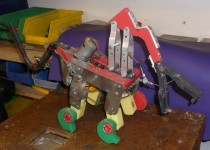3D modelled and printed right leg sub-assembly: first attempt
Previously the legs have been made manually in a variety of ways: cut out of polyethylene boards, soldered together using steel rods and laser cut out of MDF. A couple of examples are shown in the photo below:
The leg sub-assembly has been redesigned to be 3D printed.
The right leg was 3D modelled:
The design followed on from that developed on the manual version.
The leg, motor and claw assembly model is shown below:
The leg was 3D printed in grey PLA (0.15mm resolution):
Some other parts of the leg sub-assembly were printed and are shown below along with the 200:1 motor/gearbox:
The long round spigot attaches to the rectangular motor spindle:
The motor and spindle attached to the leg:
The motor clamp was attached (nb: screws need trimming).
This worked but was later modified as shown below.























